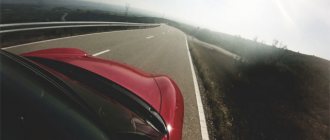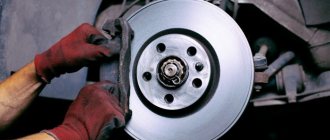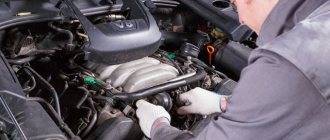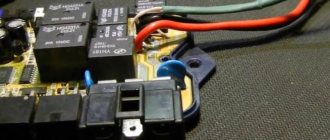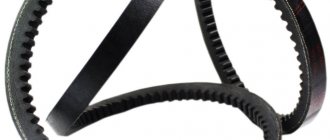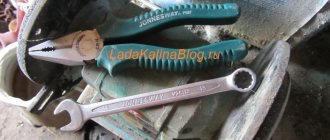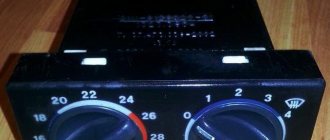There are a number of malfunctions that inevitably arise during the operation of any vehicle. A common problem is that the car pulls to the side when driving smoothly in a straight line. The problem manifests itself in different ways: in one case the car pulls strongly to the left (or right), in the second it pulls slightly on a hard road surface, in the third it skids when braking. To eliminate this dangerous phenomenon, it is necessary to find out the reasons for this behavior of the car.
Why does the car deviate from a straight line?
When the car does not want to move straight, the ride becomes uncomfortable - the driver has to constantly steer, and in some situations actually keep the car from drifting. You can’t relax - you’ll end up in a ditch or have a head-on collision with an oncoming car. It is better not to delay in finding out the cause of the problem.
Spontaneous movement of the machine from a straight path may be a sign of the following problems:
- The pressure in the front tires is very different;
- uneven wear of the front wheel treads;
- faulty steering parts;
- problems with the front suspension and chassis;
- malfunctions of the brake mechanisms.
Before looking for the cause, it is advisable to make sure that the car actually pulls to the side when you let go of the steering wheel. Example: When driving on unpaved and poorly paved roads with ruts, the wheels tend to follow the path of least resistance and are reluctant to leave the grooves. Carry out the test on a flat piece of road surface.
The bulk of the listed problems occur during the acceleration and forward movement of the car. Brake malfunctions are immediately noticeable: the car drifts when slowing down. The more intense the braking, the more the car deviates from the straight line, and the driver has to turn the steering wheel more to keep the vehicle on the desired trajectory.
This is why your car may pull to the left or to the right.
Does your car pull to the left or to the right? If you find it difficult to control your car while driving, then it is likely that it has problems. Yes, of course, the car can be pulled to the side due to the slope of the road towards the side of the road or due to the quality of the road surface. But in most cases, this sign indicates possible problems with the car.
There are many reasons that can cause a car to pull to the side. You can find out about these reasons in our article, which will help you determine the source of this problem based on various signs.
Tire problems
The pressure difference in the front wheel cylinders is the most common reason for a car to easily pull away while driving. Diagnosis could not be easier - just measure the pressure with a pressure gauge and, if necessary, pump up the sagging slope. If the car pulls to the right, then low pressure should be observed in the right wheel and vice versa. Otherwise, you need to look for the problem elsewhere.
Equally common is uneven wear of the rubber on the wheels of the front axle. The reasons for the phenomenon are:
- a car enthusiast rarely monitors tire pressure;
- the wheels have not undergone the balancing procedure;
- in front there are tires with different patterns and sizes;
- slopes with a directional pattern are installed incorrectly;
- long driving with unadjusted camber angles of the front wheels.
Rubber of varying degrees of wear often ends up on one axle as a result of seasonal replacement. The owner of the “iron horse” did not mark the removed wheels according to their installation locations and next time he put them on at random. As a result, the rear and front axle tires got mixed up.
Reference. On front-wheel drive cars, the front slopes wear out much faster than the rear ones. If the wheels are mixed up and placed on one axle, the car will begin to pull towards a lower tread.
How to solve the problem of unevenly worn rubber:
- Choose a tire with high tread instead of a worn wheel. For example, install a spare tire.
- Balance the wheels, check and adjust the camber angles. Continuing operation and waiting for the differential to complete its task will increase the load on a tire of a larger diameter, causing the tread to quickly wear out.
- Place the rear slopes forward.
Avoiding the above-described manipulations is quite simple - pump up the cylinders in a timely manner, carry out balancing at intervals of 5 thousand km and visit the camber stand every 10-15 thousand km or after a strong blow to the suspension.
Causes
First, it's worth finding out what led to the problem. It is possible that some reasons can be eliminated yourself.
1. Tires are the first thing that comes to the mind of an experienced driver. In order to find out whether the problem lies in them, you need to swap the wheels. Those that were in the front should be installed backwards, and the rear ones naturally forward. If the problem is partially solved, then it is worth installing a spare wheel on the driver’s side. Now, if this ailment has completely disappeared, then all that remains to be done is to reinstall the working tires on the problem wheel.
2. Correct installation of directional wheels. If the car has such wheels, then you need to inspect the position of the indicating arrows. If the position of the arrows points in the right direction, then it is better to think about the balance of camber and toe.
3. Camber - toe-in. It is impossible to completely eliminate this reason with your own hands. It’s better to go to a service station where there is special technology and balance the camber and toe balance. In addition, this breakdown also leads to wear of the rubber, and to other equally problematic events. However, if everything is in order with the node, you need to continue searching.
4. The steering ends in the car are either worn out or completely damaged. It is possible to check these components yourself if you have a garage with a pit. However, even if there is such a garage, but there is no experience in this matter, it is better to turn to specialists who can troubleshoot this problem and eliminate its causes. Often, this unit is replaced.
5. Wheel bearing. It would seem that the hub has nothing to do with this. This is what inexperienced car owners think. It is the failure of the wheel bearing that provokes the car to pull off the trajectory. Bearing wear disrupts the smooth rotation of the wheel, and as a result, the car pulls either to the left or to the right. This breakdown should only be corrected at a service station. One slightest mistake can cause rapid wear of the unit, which can become very dangerous, up to the breaking of the “steering knuckle”, which causes serious emergency consequences at high speeds. Rare causes
In addition to the main malfunctions, there are other reasons that can provoke such a phenomenon. For example, brake pads that have not completely moved away from the support disc. Thus, the wheel becomes wedged and smoothness is disrupted. This can be solved either by replacing the brake caliper and pads, or by completely replacing the brake elements at the front, which means replacing the support disc, brake pads and calipers, and it would also not be superfluous to replace the wheel bearing. Also, after a serious accident, elements of the chassis and body may bend. Naturally, the running gear can still be replaced, or serious work can be done on the suspension, however, solving the problem with the body will be quite problematic.
It is also worth remembering that there are standards acceptable for left-hand drive and right-hand drive cars. If the car pulls slightly to the right or left (for right-hand drive), then this is a normally adjusted hydraulic power steering. This setting is a passive safety feature that is responsible for smoothly deflecting the car from the oncoming lane in cases where the driver feels unwell or suddenly dozes off. The deviation should not be clearly expressed and manifests itself extremely slowly. If the power steering malfunctions, the car may drift in the same way as in the above situations. There is nothing terrible here, however, this is at first glance. In extreme situations, such embarrassment can seriously interfere with driving, and uneven tire wear will force you to spend even more money on them. Therefore, it is worth contacting the experts or, if you have experience, fixing this problem yourself.
Chassis and suspension malfunctions
When mechanical problems occur, the car pulls to the side much more than from the difference in tire pressure or different tread heights. The following faults cause the vehicle to be driven away:
- Worn tie rod ends. The ball pin does not turn well in the hinge, and sometimes it simply jams. A clear sign is that the steering wheel does not return to its original position on its own, the car continues to move in an arc.
- One of the steering rods was bent as a result of the impact and became several millimeters shorter. The toe angle of the front wheels is disrupted, tire wear on the affected side is accelerated, and the car is driven in the appropriate direction.
- The ball joint is stuck. The pin rotates around its own axis with great difficulty and does not allow the wheels to turn freely. At the last stage of wear, the hinge emits a loud creaking sound - a harbinger of final failure.
- The separator of one of the wheel bearings is destroyed. The balls scattered and ground into metal shavings, blocking the rotation of the hub. The car pulls towards the jammed wheel.
- After repairing the suspension, the alignment procedure was performed incorrectly or not done at all.
Advice. Not all reasons for a vehicle's deviation from a straight line are so critical. More prosaic moments also happen, for example, the bolts holding the hub have come loose. Hence the recommendation: before troubleshooting, check the reliability of the threaded connections of the suspension, chassis and steering rods.
How to diagnose these faults in a garage environment:
- Drive the car into an inspection ditch and check the steering rod ball pins. You need to grab the rod with your hand and try to rotate it around its axis. A serviceable hinge will allow it to rotate with little tension, a loose one will allow it to rotate very easily, and a jammed one will not allow it to rotate at all.
- The bent rod is also easy to notice from the inspection hole. The part must be replaced immediately, you can drive further only after adjusting the camber.
- To check the rotation of the ball joint, it is advisable to hang the front of the car and turn the wheels manually. Option two: diagnose play by alternately rocking the wheels.
- Wear and destruction of the bearing does not occur silently - the phenomenon is accompanied by a hum and grinding noise while the vehicle is moving. To check for damage, hang the wheel from the “noisy” side and spin it by hand. A broken bearing will immediately stop rotating or start grinding.
The bearing, which is in the initial stages of wear, moves the machine off the trajectory slightly. It is easier to guess about a malfunction by the buzzing sound. The damaged element is replaced immediately at the nearest car service center or on your own. If after replacement the car continues to deviate from a straight line, look for a breakdown elsewhere.
You can replace the rods and steering ends yourself (you will need a special puller), but you cannot drive further without adjusting the toe on the stand. By squeezing out the ball pins or unscrewing the tips, you will inevitably break the old settings.
Poor wheel alignment adjustment on the rear wheel axle
Due to improper alignment of the rear wheel, the steering wheel can also pull to the side. This problem is especially typical for wheels with different camber angles. Steering play is normal, because even the traffic rules do not prohibit driving a car with such a defect. The normal play for a passenger car is 10 degrees, but even with such play the steering wheel will be felt to deviate to the side. If the play is too strong, you can’t drive the car, and the problem needs to be fixed urgently. All that was listed above are defects that the motorist can fix himself or at a car service center. But in addition to the above, other, even more serious, malfunctions are possible - bending of the steering rack, defects in rods, rollers and other parts of the steering mechanism. To fix the problem, you should contact the service for diagnostics and repair work.
Brake problems
Problems with brake mechanisms appear both after pressing the pedal and while driving. The reasons are as follows:
- complete failure of one of the working cylinders, including on the rear axle;
- jamming of the working cylinder piston in various positions;
- fluid leakage from the brake circuit tube;
- failure of the hydraulic valve of the anti-lock braking system.
When the working cylinder on one of the front wheels fails, the car literally rolls away after sharply pressing the brake. If the car pulls to the left, it means the right cylinder is not functioning and vice versa. When the brake cylinder of the rear axle fails, the car does not pull away so clearly. The easiest way to find the “culprit” is by leaking brake fluid, inspecting each hub from an inspection ditch or simply looking under the car.
On cars with high mileage and worn calipers, the piston of the working cylinder may become stuck in the position of squeezing the pads. The wheel on the side of the faulty mechanism is continuously braked, and the car constantly moves in the same direction. It is easy to identify a breakdown: after driving 1–2 km, feel all the wheel rims with your hand. The “culprit” will be revealed by the heated rim.
If the piston of the working cylinder is frozen in a free position, then the vehicle will drift during the braking process - the car will drift in the direction opposite to the non-working mechanism. To finally make sure that the element is broken, hang the wheel from the suspicious side and try to spin it with the brake pedal pressed.
Diagnosing anti-lock braking system (ABS) problems in a garage environment is difficult. If fluid does not pass through one of the valves, you will have to disassemble the calipers and make sure that the cylinders are functioning normally. It’s easier to go to the nearest car service center, where technicians will check the brakes using specialized equipment.
Why does the steering wheel pull to the side when braking?
But if the symptom of steering wheel slip appears exclusively during braking, then, most likely, the brake pads are jammed on the brake disc or drum. This is also easy to understand - drive at a normal pace for 10-15 minutes, periodically working the brake pedal - use your brakes, and then stop and check how hot the brake discs are on the front wheels - be careful not to get burned: do not touch the calipers immediately after stops, and first splash a drop of water into them or just spit - if the water (saliva), barely touching the surface, boils (provided that you did not brake for a long time “to the floor”), then this means that the pads are stuck in the caliper while pressed position towards the brake disc. In this case, most likely, such a problem will be observed only on one side of one specific wheel of the car. Also, check the brake pads themselves for uneven wear. But to eliminate this malfunction after identifying it, you will again have to contact a specialist auto mechanic.
